JCB puts hydrogen combustion into action
03 April 2023
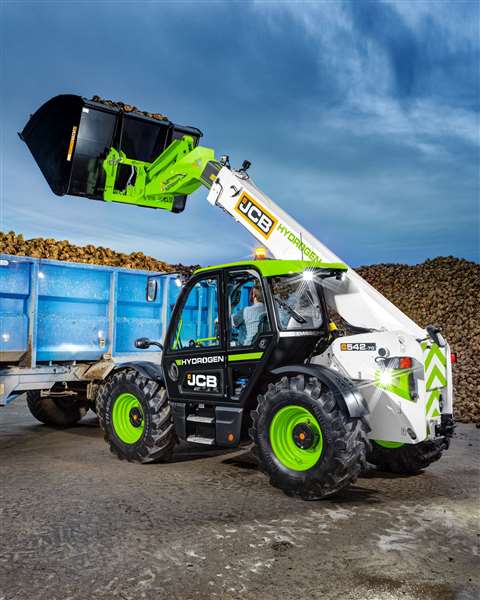 JCB is using hydrogen combustion engines in working test models of its 3CX backhoe-loader and 542-70 Loadall telehandler. (Photo: JCB)
JCB is using hydrogen combustion engines in working test models of its 3CX backhoe-loader and 542-70 Loadall telehandler. (Photo: JCB)
When it comes to new product innovation, you can often learn as much from failures as from successes. This has certainly proven the case in development of hydrogen combustion engine technology. With numerous attempts made in the ’90s to produce a working model, 76 technical papers describing what worked and, more importantly, what didn’t have been instrumental in pointing future development efforts in the right direction.
“We studied the 76 papers – experiments by universities, top companies – and wh-at we realized when we got to the end of it was that the majority of those engines were conversions,” said Tim Burnhope, chief innovation and growth officer at JCB. Most attempts involved trying to put hydrogen into an existing spark ignition engine. “You wouldn’t put petrol in a diesel engine and expect it to work. And that’s really what people have been doing with hydrogen.
“The problem was the combustion was probably high pressure, high temperature. The fuels were probably too rich. So, the outcomes were fairly poor.”
After dissecting the studies, JCB engineers identified 11 key technical challenges that needed to be addressed. Of these, the majority, said Burnhope, came back to how you combust hydrogen in the first place, including the need to combust at much lower temperature and pressure and at a very lean mix of hydrogen to air.
“The only way you get the large content of air is to have a turbocharger that’s very powerful that can put a lot more air through the system,” Burnhope said. “In the ’90s, those turbochargers weren’t available, so the majority of the people who were doing the experiments didn’t have the ability to change the injection process or the turbocharger process to supply the air… And the one thing they definitely didn’t have was the computing power to be able to run simulations.”
Fast forward a couple of decades to 2020 when such barriers no longer existed. Working closely with the University of Aachen in Germany, JCB took advantage of available computer simulation technology to identify the precise elements of compression ratio, temperature, pressure and fuel-to-air mix required – resulting in what Burnhope described as “an amazing breakthrough.”
Principles of hydrogen combustion
That breakthrough is a “first-principles hydrogen combustion solution,” in which roughly 70% of the engine appears the same as its diesel counterpart.
“Essentially, from the top of the block down… it’s exactly the same characteristics so the engine gives the same output,” Burnhope said. “What we’ve done really is take off today’s combustion process and put a new combustion process on the top.”
The proprietary hydrogen combustion process incorporates a new cylinder head and a port fuel injection system that ensures proper passage of a gas, rather than a fluid, into the engine. A variable geometry turbocharger is utilized to force air into the cylinders, where spark ignition is then used to ignite the fuel mixture.
“Conditions are such that we need to ignite it with a spark,” said Paul McCarthy, JCB chief engineering – hydrogen engines performance, controls & integration. The spark plugs used must also be able to stand up to harsh off-road environments.
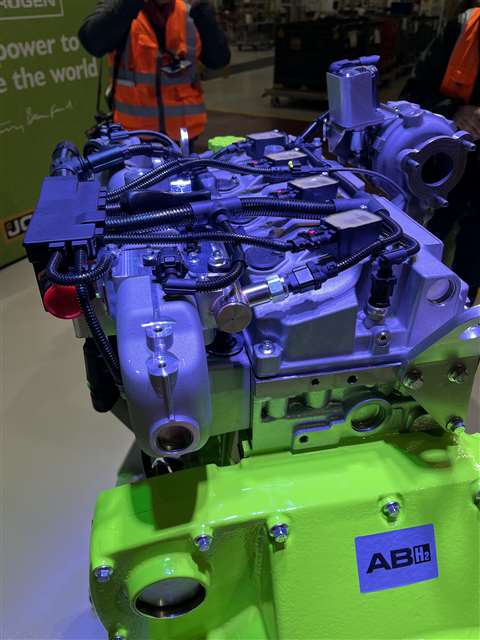 The hydrogen combustion system includes a new cylinder head, port fuel injection system and variable geometry turbocharger. Spark ignition is used to ignite the very lean fuel-to-air mixture. (Photo: KHL Staff)
The hydrogen combustion system includes a new cylinder head, port fuel injection system and variable geometry turbocharger. Spark ignition is used to ignite the very lean fuel-to-air mixture. (Photo: KHL Staff)
Because combustion takes place at a lower temperature, JCB’s hydrogen combustion solution results in a much cleaner burn with zero CO2 emissions. The only output from the exhaust is steam – water content which must be carefully managed to prevent contaminating the engine oil or causing embrittlement of certain metals.
“Combustion does generate water today, but it’s a little more [with hydrogen] because of the combustion method,” McCarthy said. “The solution to this is evolutions of readily available material science technology – coatings, stainless steels to avoid corrosion – but also… the oils.”
JCB is currently working to develop a blend of specialized oils and additives to minimize water contamination risk.
Almost invisible to operators
The 4.8 L hydrogen combustion engine developed by JCB fits in the same footprint as its diesel counterpart. “The engine physical size and mounting is the same. We use the same cooling pack, same chassis, same position,” Burnhope stated. “The engine is totally interchangeable.”
Service is largely the same, as well. “I have complete confidence in the whole dealer network to service the machine... It’s pretty much to them the same engine. The only difference – four spark plugs and working out how to cope with clean (carbon-free) oil,” Burnhope said.
Operational changes are barely perceptible, as well. “Those with a keen ear will notice a slight difference in the combustion noise. You’ll notice a slightly softer combustion brought about by the spark ignition,” said Lee Harper, chief engineer – electrification, JCB. “But other than that, it starts, runs, operates exactly the same as today’s product. It’s effectively invisible to the operator.”
This was a key criterion from the outset. “We made it very clear to our engine design team that the product that we sell at the end of this solution will be identical,” Burnhope said. “We got the combustion to work and then we’ve refined and refined so we have low-end torque perfect, if not slightly better…
“If you were to jump onto a hydrogen backhoe, as an operator, there is no difference at all – until you come to fuel the machine.”
In place of a diesel fuel tank, operators will find an automotive-grade, carbon composite-wrapped hydrogen tank, which is built as a sub-assembly module. The tank stores and then decants hydrogen at a low pressure to the engine.
Despite the difference in both tank and fuel, JCB is working to make the refueling process largely comparable to traditional on-site refueling. It has even developed its own mobile hydrogen refueler.
“A key element that hydrogen gives us over electricity or any other fuel source, really, is the speed of replenishment,” Harper commented. “We can right-size the fuel tanks for the typical customer, and those that are heavy use customers can replenish in minutes.”
Next steps
JCB has its hydrogen combustion engine fitted and working in multiple pieces of equipment, and pre-production engines are rolling off a dedicated production line at the JCB Power Systems factory in Derbyshire, UK.
“Step one was to get the engine to work. We’ve done that. Step two was to get the machines to perform, and we’ve pretty much done that. Step three is validating the engine and the machines to get them to a level for production, and we’re well into that with a lot of machines now up and running,” said Burnhope.
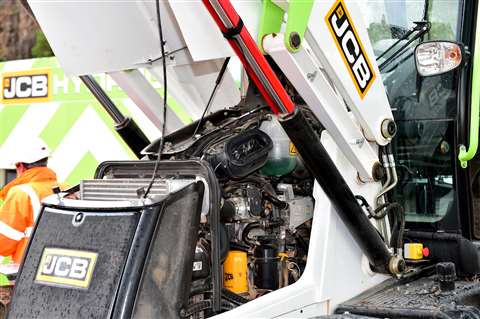 Shown is a hydrogen combustion engine installed on a JCB backhoe-loader. (Photo: JCB)
Shown is a hydrogen combustion engine installed on a JCB backhoe-loader. (Photo: JCB)
“We’ve actually built our 50th hydrogen engine,” McCarthy said, “so this isn’t a science experiment. This is real. This is happening… We’re already proving out our production techniques [so that it] will be ready to build.”
Currently, the company is working with key customers to educate and instill confidence. “Key customers want time to be able to understand the product, but more importantly, they’re now starting to plan what a net-zero jobsite could look like,” Burnhope said.
JCB will also show the engines for the first time on an international stage at IFPE during ConExpo 2023. “What we really want to do is to share the technology – we want to pass on the confidence,” Burnhope said. “This is a spectacular solution for the world to get to net zero much, much quicker.”
Hydrogen combustion-powered machines can be used, serviced and sold for a second life in exactly the same way, anywhere hydrogen is being adopted, he added. “We believe that… people adopt technology when it’s affordable and when it’s similar to what they’re using today.
“Do I think we’ll suddenly sell thousands and thousands of machines on day one? Probably not. It will be a bit like the electric machines. Customers want to try them. They want to evaluate them. They want to gain confidence.
“So, my guess is they’ll start to take machines for net-zero sites, and over one to two years, that confidence will grow very quickly. And we’re confident of that because ours has grown quickly.”
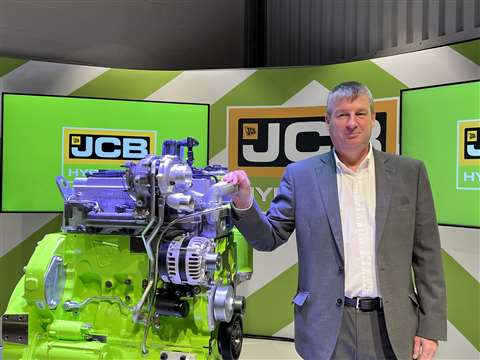 JCB’s Tim Burnhope stands next to a pre-production model of the 4.8 L hydrogen combustion engine. (Photo: KHL Staff)
JCB’s Tim Burnhope stands next to a pre-production model of the 4.8 L hydrogen combustion engine. (Photo: KHL Staff)
JCB’s hydrogen combustion engines will initially be limited to internal use in the company’s construction machines. But if demand proves out, they won’t be limited for long.
“First and foremost, we focused on JCB, but we’ve had an incredible level of inquiries,” JCB’s Tim Burnhope said. “Lots of industries want to work with us, asking when the engine is available to take on board.”
JCB already sells 10% to 15% of the engines it produces to third parties. “We also have many other companies now very interested [in the hydrogen combustion engine], so it’s a really good opportunity.
“And it is scalable. [In terms of] horsepower, up or down, it’s a very scalable solution.”
That means even more applications – and prospects for third-party engine sales – lie ahead.
ON-SITE HYDROGEN DELIVERY
For hydrogen to be a truly viable fuel for off-road use, it must be capable of being delivered to equipment where it is working. Since 97% of its construction equipment typically requires refueling on site, JCB chose to develop a solution in the form of a mobile hydrogen refueler.
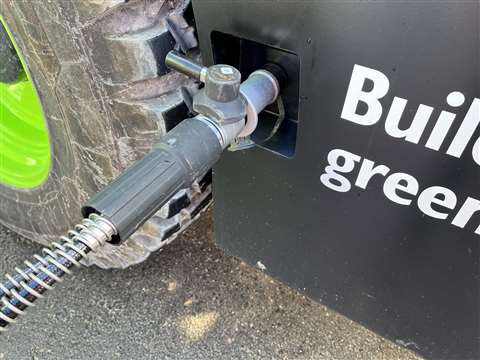 JCB’s mobile hydrogen refueler is able to refuel a 5 to 6 kg tank on a backhoe-loader in as little as 10 to 15 minutes. (Photo: KHL Staff)
JCB’s mobile hydrogen refueler is able to refuel a 5 to 6 kg tank on a backhoe-loader in as little as 10 to 15 minutes. (Photo: KHL Staff)
Based on the company’s Fastrac tractor, the refueler is powered by a hydrogen combustion engine and features hydrogen tanks mounted on the back. According to the company, it is able to refuel a 5 to 6 kg tank on a backhoe-loader in as little as 10 to 15 minutes.
The completely sealed system includes two lines – a high-pressure line that transfers hydrogen from the refueler to the tank and a second vent line. Refueling is as simple as plugging the nozzle end into the machine’s onboard tank, locking it in place with a turn of a handle and then turning the system on at the refueler to initiate fuel transfer.
The process is seamless and leak- and spill-free since any fuel escaping during refueling is released harmlessly into the atmosphere.
While dedicated for JCB machines, the refueler does open the door for adoption of hydrogen combustion-powered equipment on a broader range of jobsites, including those in remote locations with limited access to hydrogen refueling stations.
POWER SOURCING GUIDE
The trusted reference and buyer’s guide for 83 years
The original “desktop search engine,” guiding nearly 10,000 users in more than 90 countries it is the primary reference for specifications and details on all the components that go into engine systems.
Visit Now
STAY CONNECTED




Receive the information you need when you need it through our world-leading magazines, newsletters and daily briefings.
CONNECT WITH THE TEAM













